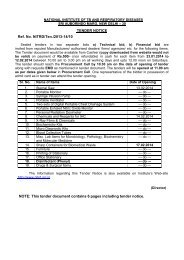The Indian Journal of Tuberculosis - LRS Institute of Tuberculosis ...
The Indian Journal of Tuberculosis - LRS Institute of Tuberculosis ...
The Indian Journal of Tuberculosis - LRS Institute of Tuberculosis ...
Create successful ePaper yourself
Turn your PDF publications into a flip-book with our unique Google optimized e-Paper software.
LASER THERAPY IN TUBERCULOSIS 139<br />
Out <strong>of</strong> 61 patients, 43 (70.41%) improved<br />
radiologically as compared to 22 (36.06%) in control<br />
group (Table 5). Maximum improvement was seen<br />
in single cavity. Radiological improvement was seen<br />
in terms <strong>of</strong> complete closure <strong>of</strong> cavity in 20% <strong>of</strong><br />
improved patients and regression <strong>of</strong> cavity and<br />
thinning <strong>of</strong> the wall <strong>of</strong> cavity in 42.85% <strong>of</strong> improved<br />
patients. Rest <strong>of</strong> the patients’ cavity size remained<br />
as such.<br />
Five patients had slight Haemoptysis, 7<br />
developed pneumothorax, all were managed<br />
conservatively.<br />
All patients, who completed full course<br />
<strong>of</strong> treatment, were followed up for an average<br />
period <strong>of</strong> 3 years. Seven patients (11.47%)<br />
showed bacteriological relapse while 4<br />
(6.55%) relapsed within 6 months and 3<br />
(4.91%) relapsed after 12 months after<br />
completion <strong>of</strong> treatment.<br />
DISCUSSION<br />
Multi drug resistant pulmonary<br />
tuberculosis (MDR-PTB) is one entity which<br />
presently has no other modality <strong>of</strong> treatment<br />
except the second line drugs like Cycloserin,<br />
Kanamycin, Ethionamide, Prothionamide, PAS and<br />
so on, which in a developing country like India<br />
is a costly affair. Also these drugs are not freely<br />
available, therefore the patients’ compliance<br />
becomes poor. <strong>The</strong> use <strong>of</strong> alternative modalities<br />
<strong>of</strong> treatment for tuberculosis like UV radiation,<br />
electrotherapy, and drugs like iod<strong>of</strong>orm and<br />
formaldehyde have been recognized for over one<br />
hundred years. Before the advent <strong>of</strong><br />
chemotherapeutic drugs, agents like iod<strong>of</strong>orm and<br />
formaldehyde have been used in treatment <strong>of</strong><br />
phthisis (tuberculosis) with some success.<br />
Radioactive agents such as radium thorium have<br />
also been used in treatment <strong>of</strong> tuberculosis as early<br />
as 1903 by Soddy et al. Hence it was proven that<br />
apart from chemotherapeutic drugs, alternative<br />
modalities <strong>of</strong> treatment have a role in treatment.<br />
Although the exact mechanism by which<br />
beneficial effects <strong>of</strong> LLLT observed in<br />
tuberculosis is not known but it has been observed<br />
that nitrogen laser irradiation leads to temporary<br />
inactivation <strong>of</strong> drug sensitive as well as drug<br />
resistant clinical isolate <strong>of</strong> MTB6. UVA radiation<br />
has been reported to lead to alteration in cell<br />
membrane properties via damage to membrane<br />
lipid 7-9 . Nitrogen laser irradiation alters the fluidity<br />
<strong>of</strong> lipid region <strong>of</strong> the cell wall 6 .<br />
Another important aspect concerning<br />
Nitrogen laser irradiation (337nm)induced inactivation<br />
<strong>of</strong> MTB is that UV (320-400nm)irradiation <strong>of</strong> cell<br />
is known to lead to generation <strong>of</strong> oxygen radicals<br />
as singlet oxygen photosensitized reaction involving<br />
endogenous photochromophore 10 .<br />
Out <strong>of</strong> 61 patients, 44(72%) became<br />
sputum smear and culture negative for MTB in LLLT<br />
group. Among those who achieved Bacteriological<br />
conversion, 22 patients (50%) converted within first<br />
month as compared to 26.92 in control . Sputum<br />
conversion rate is higher and faster in LLLT group<br />
as compared to control group. Similar studies were<br />
also conducted in Tashkent by Eshankhanov 3 et al<br />
and in India by Bhagwanani et al 11 ,Puri M.M. 12 ,<br />
yielding similar results.<br />
Maximum improvement was seen in<br />
younger age group with resistant to one drug and<br />
single cavity. Patients who completed treatment were<br />
followed up for 24 to 36 months. 7 patients showed<br />
bacteriological relapse because <strong>of</strong> poor drug<br />
compliance and multiple cavities.<br />
Laser therapy for MDR-PTB is a newer<br />
modality <strong>of</strong> treatment which gives patients a ray<br />
<strong>of</strong> hope for better quality <strong>of</strong> life. Results are<br />
encouraging and LLLT is well tolerated by the<br />
patients. Further work is now required to<br />
evaluate the basic mechanism <strong>of</strong> action <strong>of</strong> laser<br />
and optimize the parameter as far as dose<br />
delivery and duration <strong>of</strong> laser irradiation is<br />
concerned.<br />
ACKNOWLEDGEMENTS<br />
We thank Mr. A.G. Bhujle, Head,<br />
Instrumentation and Control Division, CAT &<br />
<strong>Indian</strong> <strong>Journal</strong> <strong>of</strong> <strong>Tuberculosis</strong>
















